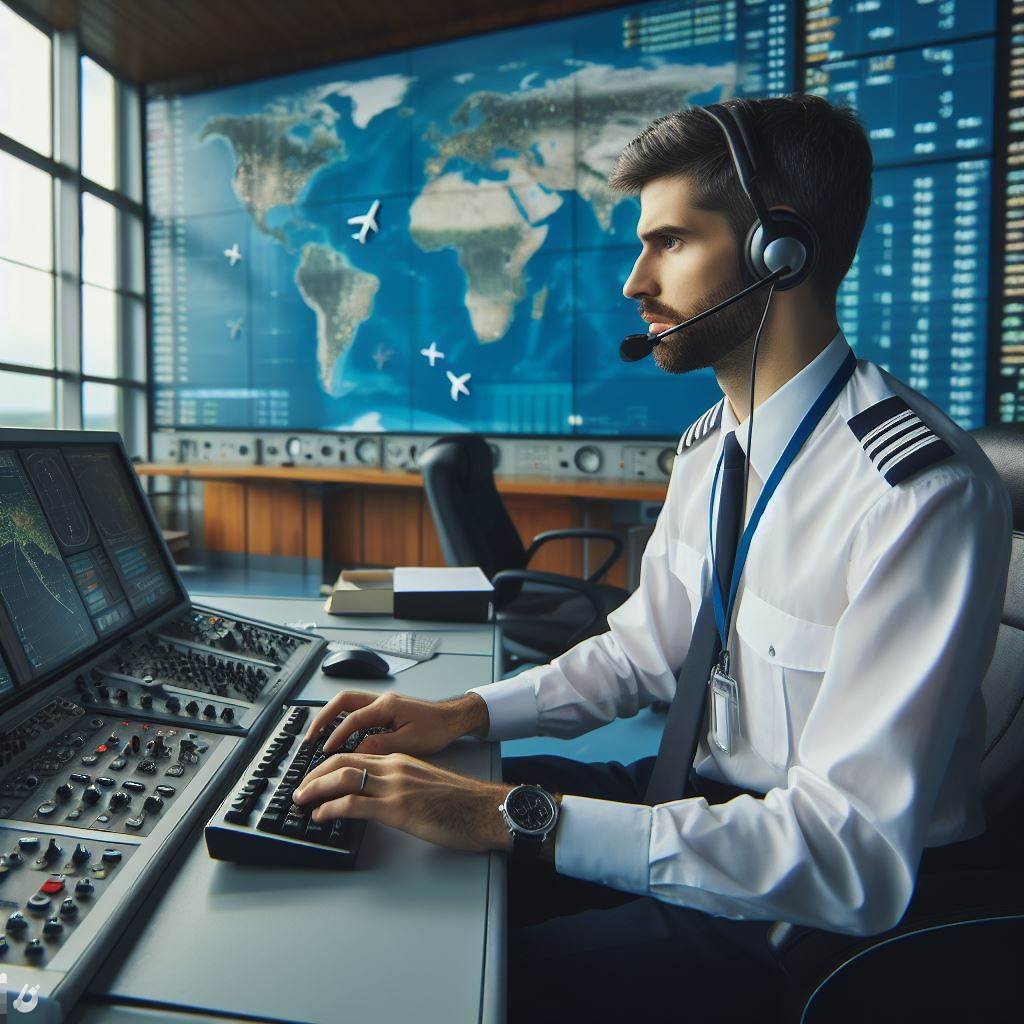Introduction
Exploring how UK Air Traffic Controllers (ATCs) handle aircraft movement in extreme weather scenarios reveals their crucial role in ensuring the safety and efficiency of UK airspace.
They play a crucial role in ensuring safe and efficient air travel. However, they often encounter numerous challenges when dealing with extreme weather scenarios.
Extreme weather poses significant difficulties for UK ATCs as it can disrupt flight schedules, create hazardous conditions, and increase the risk of accidents.
These scenarios demand swift and precise action to maintain operational safety.
Thunderstorms, for example, can lead to lightning strikes, strong winds, and heavy precipitation, making it challenging for ATCs to coordinate aircraft movements.
They must constantly monitor radar data and collaborate with pilots to adjust flight routes and altitudes accordingly.
Another weather challenge is fog, which severely limits visibility and requires ATCs to rely heavily on instruments and communication systems.
They must guide pilots using accurate and timely information to prevent potential collisions.
Snow and ice also pose threats to aircraft operations, as they can impact runway conditions and decrease aircraft performance during takeoff and landing.
ATCs closely monitor weather reports, coordinate de-icing procedures, and implement special measures to ensure safe operations.
Additionally, ATCs must consider the effects of extreme weather on airports’ infrastructure, such as damaged runways or reduced capacity due to snow clearance.
These factors further complicate their task of managing air traffic during adverse weather conditions.
In fact, UK ATCs face numerous challenges when handling extreme weather scenarios.
Their ability to adapt quickly, maintain effective communication, and make critical decisions is crucial to ensuring the safety and efficiency of air travel in such conditions.
Role of UK ATCs in Extreme Weather Scenarios
A. Explanation of ATCs
Air Traffic Controllers (ATCs) are professionals who are responsible for managing and directing air traffic.
Personalized UK Career Consulting
Receive tailored career guidance designed just for you. Get actionable steps and expert support to boost your career in 1-3 days. Take control of your career now.
Get StartedIn extreme weather scenarios, their crucial role in ensuring aviation safety becomes even more evident.
During extreme weather conditions such as heavy rain, snowstorms, or strong winds, ATCs face immense pressure and responsibility.
They must make quick and accurate decisions to maintain the flow of air traffic and avoid any potential dangers.
One of the primary responsibilities of ATCs during extreme weather scenarios is to monitor the weather conditions closely.
They rely on weather reports from meteorological agencies and radar systems to stay informed about the changing weather patterns.
B. The role they play in ensuring aviation safety during extreme weather conditions
ATCs play a vital role in coordinating with pilots and providing them with real-time information about the weather conditions.
They inform pilots about areas of turbulence, strong crosswinds, or stormy weather along their flight routes, allowing them to make necessary adjustments.
ATCs also collaborate with other stakeholders, such as airport authorities and ground staff, to manage the impact of extreme weather on airport operations.
They ensure that runways, taxiways, and other essential infrastructure remain safe and functional, despite the challenging weather conditions.
Furthermore, ATCs are responsible for maintaining adequate separation between aircraft during extreme weather scenarios.
They need to ensure that aircraft are sufficiently spaced apart to avoid collisions or dangerous wake turbulence caused by adverse weather conditions.
The role of ATCs goes beyond just managing air traffic.
They also act as a communication channel between pilots and other relevant authorities, such as emergency services or air traffic control centers in neighboring countries.
To handle extreme weather scenarios effectively, ATCs undergo rigorous training programs.
Your Dream Job Starts with a Perfect CV
Get a tailored CV and cover letter that captures your unique strengths and stands out in your industry. Let us help you make an unforgettable first impression.
Get StartedThey learn how to interpret weather information accurately, make timely decisions, and prioritize safety above all else. The training equips them with the necessary skills and knowledge to handle high-pressure situations effectively.
Throughout their careers, ATCs develop expertise in managing various weather scenarios.
They gain experience in dealing with thunderstorms, fog, heavy snowfall, or even volcanic ash clouds, which can pose significant challenges to aviation operations.
In short, ATCs play a crucial role in managing and directing air traffic, especially during extreme weather scenarios.
They face immense pressure and responsibility as they ensure aviation safety in challenging conditions.
Through close monitoring of weather conditions and effective communication with pilots and other stakeholders, ATCs maintain the flow of air traffic and prioritize safety above all else.
Read: The Future of Air Traffic Control in the UK
Types of Extreme Weather Scenarios ATCs Handle
A. Overview of the various types of extreme weather scenarios in the UK
When it comes to handling extreme weather scenarios, air traffic controllers (ATCs) in the UK face a wide range of challenges.
From heavy rain to snowstorms, thunderstorms, and even hurricanes, these professionals must be prepared for anything that Mother Nature throws their way.
The UK is known for its ever-changing weather patterns, which can be highly unpredictable and diverse.
ATCs must stay vigilant and adapt their strategies to ensure the safety and efficiency of air travel in such conditions.
1. Heavy rain
Heavy rain is one of the most common types of extreme weather scenarios that ATCs encounter.
This can lead to reduced visibility, slippery runways, and potential lightning strikes, which can pose a risk to both aircraft and passengers.
ATCs closely monitor weather forecasts and work closely with pilots to determine the best course of action, whether it’s rerouting flights or adjusting landing and takeoff procedures.
Optimize Your LinkedIn for Success
Boost your LinkedIn profile with a professional bio, keyword-rich headline, and strategic recommendations that attract recruiters. Stand out from the crowd and get noticed.
Optimize Now2. Snowstorms
Snowstorms also present significant challenges for ATCs.
The UK may not experience heavy snowfall as frequently as some other countries, but when it does occur, it can disrupt flight operations and cause delays.
ATCs work closely with airport authorities and ground staff to ensure that runways are clear and safe for aircraft to land and take off.
They also coordinate with pilots to adjust flight paths or delay departures if necessary.
3. Thunderstorms
Thunderstorms can be particularly problematic for air traffic controllers.
These weather events bring strong winds, heavy rain, and lightning, which can pose serious risks to aircraft.
ATCs closely monitor the movement of thunderstorms and communicate with pilots to avoid areas of intense activity.
They may also implement ground stops or reroute flights to prevent any potential hazards.
4. Hurricanes
While hurricanes are relatively rare in the UK, they can still occur, particularly in the western parts of the country.
ATCs maintain constant communication with meteorologists and are prepared to take immediate action if a hurricane approaches.
This may involve diverting flights, closing airports, or even grounding aircraft until the storm passes.
B. The diversity and unpredictability of weather patterns in the UK
It’s important to emphasize the diversity and unpredictability of weather patterns in the UK.
ATCs must stay informed about changing weather conditions and be ready to adapt their plans at a moment’s notice.
Whether it’s heavy rain, snowstorms, thunderstorms, or hurricanes, they are tasked with ensuring the safety and efficiency of air travel, regardless of what the weather throws at them.
In essence, ATCs in the UK handle a variety of extreme weather scenarios, including heavy rain, snowstorms, thunderstorms, and even hurricanes.
Their ability to adapt and make informed decisions in unpredictable conditions plays a crucial role in the safety of air travel across the country.
Read: A Day in the Life of a UK Logistic Coordinator
Challenges Faced by UK ATCs
A. The unique challenges ATCs encounter during extreme weather scenarios
ATCs encounter unique challenges during extreme weather scenarios, which can significantly impact air traffic control operations.
B. Impact of Reduced Visibility
- Reduced visibility caused by fog, heavy rain, or snow poses a major challenge for ATCs.
- It hampers their ability to visually identify and track aircraft, increasing the risk of collisions.
- ATCs rely heavily on radar systems and instrument flight rules to manage air traffic safely.
C. Effects of Strong Winds
- Strong winds, especially during storms, create turbulence and affect aircraft performance.
- ATCs must constantly monitor wind conditions to ensure safe takeoffs, landings, and flight routes.
- They need to coordinate with pilots in real-time to adjust for crosswinds and wind shear.
D. Weather-Related Factors
- Extreme weather scenarios, such as thunderstorms and icing conditions, disrupt air traffic flow.
- ATCs need to reroute aircraft to avoid hazardous weather areas, causing delays and congestion.
- Weather-related factors also impact communication systems and affect the reliability of information exchange.
E. Increased Workload and Stress
- During extreme weather scenarios, ATCs face a surge in workload due to the need for constant monitoring.
- They must handle a higher volume of communications, including updating pilots with real-time weather information.
- The stress levels of ATCs rise as they navigate through complex scenarios and make critical decisions swiftly.
- Managing efficient flow control becomes challenging, necessitating quick adjustments to prevent bottlenecks.
In general, UK ATCs face a range of challenges during extreme weather scenarios.
The impact of reduced visibility, strong winds, and other weather-related factors significantly affects air traffic control operations.
The increased workload and stress they experience underscore the importance of their role in maintaining safe and efficient flight operations.
Read: UK Logistics: Skills for Success in Coordination

Training and Preparation for Extreme Weather Scenarios
Effective management of extreme weather scenarios requires extensive training and preparation for Air Traffic Controllers (ATCs).
This section highlights the importance of such training and provides an insight into the specific programs and simulations ATCs undergo.
Additionally, continuous education and skill updating are essential to ensure proficiency with the latest technologies and techniques.
A. Importance of Extensive Training and Preparation for ATCs
In the high-stakes field of air traffic control, there is no room for error, especially during extreme weather scenarios.
ATCs play a critical role in ensuring the safety and efficiency of air travel.
Therefore, extensive training and preparation are crucial to handle the challenges posed by extreme weather conditions.
ATCs need to be well-versed in assessing weather conditions, understanding meteorological reports, and predicting potential hazards.
They must possess the skills and knowledge to make informed decisions that prioritize safety while minimizing disruptions to air traffic.
This level of expertise can only be achieved through comprehensive training and preparation.
B. Specific Training Programs and Simulations
ATCs undergo rigorous training programs and simulations that prepare them for handling extreme weather scenarios.
These programs focus on developing critical thinking skills, decision-making abilities, and situational awareness in the face of challenging weather conditions.
Simulations play a vital role in recreating realistic scenarios and testing ATCs’ ability to manage air traffic during adverse weather.
These simulations allow ATCs to practice their skills in a controlled environment, enabling them to gain valuable experience without jeopardizing the safety of air traffic.
The training programs also emphasize effective communication and coordination among ATCs, pilots, and other stakeholders.
Timely and accurate exchange of information is crucial during extreme weather scenarios to ensure efficient decision-making processes and to keep everyone involved well-informed.
C. Continuous Education and Skill Updating
The aviation industry is constantly evolving, with the introduction of new technologies and techniques to enhance safety and efficiency.
To stay up-to-date with these advancements, ATCs must engage in continuous education and skill updating.
Regular training refreshers and courses enable ATCs to familiarize themselves with the latest technological systems and regulations.
They also equip ATCs with the necessary skills to adapt to changing weather patterns and emerging challenges.
Furthermore, ATCs actively participate in workshops and conferences where they can exchange knowledge, experiences, and best practices with their peers.
These events provide opportunities to learn about innovative strategies and approaches to handling extreme weather scenarios, ultimately enhancing the overall competency of ATCs.
Training and preparation are vital for ATCs to effectively handle extreme weather scenarios.
Through extensive training programs, simulations, continuous education, and skill updating, ATCs are equipped with the necessary expertise to manage air traffic during adverse weather conditions.
ATCs’ ability to make informed decisions while prioritizing safety contributes to a resilient and efficient air traffic control system.
Read: Balancing Life: Train Driver Edition
See Related Content: UK’s Best Truck Stops: Driver Reviews
Collaborative Efforts with Weather Forecasting Authorities
In the fast-paced world of air traffic control (ATC), handling extreme weather scenarios demands precise communication and decisive decision-making.
Here’s an insight into the intricate process:
A. Communication Protocols
- Immediate Weather Updates: ATCs prioritize real-time weather updates to anticipate and mitigate potential disruptions.
- Collaborative Briefings: Regular briefings among controllers ensure a unified response, enhancing situational awareness.
- Direct Pilot Communication: Clear and concise communication with pilots is crucial for conveying critical weather-related instructions.
- Automated Systems: Integration of advanced technology ensures swift dissemination of weather data across all relevant channels.
- Emergency Frequencies: ATCs establish and monitor emergency frequencies for swift coordination during extreme weather events.
B. Decision-making Process
- Risk Assessment: Controllers conduct thorough risk assessments to gauge the severity of weather conditions.
- Collaborative Decision-making: Coordination with meteorologists, airlines, and pilots aids in making informed decisions collectively.
- Dynamic Routing: ATCs utilize dynamic routing to divert flights away from hazardous weather areas, ensuring passenger safety.
- Priority Landing: Decisions regarding priority landing are made based on the urgency of the situation and available resources.
- Continuous Monitoring: Constant monitoring allows for real-time adjustments, ensuring flexibility in response to evolving weather patterns.
C. Collaboration with Pilots and Airlines
- Regular Consultations: ATCs maintain open lines of communication with pilots and airlines for continuous updates and feedback.
- Shared Decision Platforms: Collaborative platforms facilitate shared decision-making, promoting a holistic approach to managing extreme weather challenges.
- Emergency Protocols: Pre-established emergency protocols ensure seamless collaboration between ATCs, pilots, and airlines during adverse weather conditions.
To summarize, effective communication and decisive decision-making are the cornerstones of how UK ATCs navigate the complexities of extreme weather scenarios, safeguarding both air traffic and passenger well-being.
Communication and Decision-Making during Extreme Weather Scenarios
A. Communication protocols followed by ATCs during extreme weather scenarios
In the face of extreme weather scenarios, air traffic controllers (ATCs) adhere to strict communication protocols to ensure the safety and efficiency of air traffic.
The communication protocols followed by ATCs during extreme weather involve timely and accurate transmission of information to all relevant parties.
ATCs maintain constant communication with pilots, airlines, and other ATCs to exchange critical weather updates and coordinate necessary actions.
B. Decision-making process involved in handling air traffic during adverse weather conditions
These protocols ensure that everyone involved is well-informed and able to make informed decisions in real-time.
When handling adverse weather conditions, the decision-making process becomes a crucial component in maintaining air traffic flow.
ATCs analyze the severity and impact of weather conditions on airport operations and take decisions accordingly.
The decision-making process involves carefully assessing weather forecasts, current conditions, and available airport resources.
Collaboration with pilots and airlines plays a vital role in efficient decision-making during extreme weather scenarios.
ATCs actively seek input from pilots regarding the conditions they are experiencing in-flight, enabling them to better gauge the overall situation.
Pilots’ firsthand information allows ATCs to make more accurate decisions in rerouting flights or holding them on the ground when necessary.
C. Collaboration with pilots and airlines for efficient decision-making
Furthermore, ATCs work closely with airlines to understand their operational limitations during adverse weather conditions.
These collaborative efforts facilitate effective decision-making, taking into account the capabilities and constraints of all stakeholders involved.
ATCs prioritize safety above all else and constantly reassess their decisions based on the ever-changing weather conditions.
Regular communication updates enable ATCs to quickly adapt and make necessary adjustments to the current air traffic management plans.
In extreme cases, ATCs may need to implement contingency measures to handle sudden changes in weather conditions.
For example, if a severe thunderstorm suddenly develops near an airport, ATCs may divert incoming flights to alternate airports to avoid risks.
Collaboration with meteorological services also plays a crucial role in decision-making during extreme weather scenarios.
ATCs work closely with meteorologists to gather accurate and timely weather information to inform their decision-making process.
Regular updates from meteorologists allow ATCs to anticipate adverse weather events and proactively plan ahead.
In a nutshell, effective communication protocols and careful decision-making are essential for ATCs when handling air traffic during extreme weather scenarios.
Collaborating with pilots, airlines, and meteorologists ensures efficient information flow and enables prompt and well-informed actions.
These measures ultimately enhance the safety and effectiveness of air traffic management in adverse weather conditions.
Conclusion
In the eye of storms, UK Air Traffic Controllers (ATCs) masterfully navigate chaos, ensuring aviation safety.
Their pivotal role in extreme weather scenarios encompasses swift decision-making, expert coordination, and precise communication.
Kudos to these unsung heroes! The seamless orchestration of air traffic during adverse conditions reflects their unparalleled expertise, honed through rigorous training.
Their unwavering dedication safeguards skies and lives, a testament to their indispensable role in aviation.
As weather patterns evolve, so must our strategies. UK ATCs exemplify adaptability, a trait crucial for handling future challenges.
Continuous improvement remains paramount, ensuring these guardians of the sky stay ahead of the curve, ready to overcome whatever weather may come.
[E-Book for Sale]
500 Cutting-Edge Tech Startup Ideas for 2024 & 2025: Innovate, Create, Dominate
$19.99 • 500 Tech Startup Ideas • 62 pages
You will get inspired with 500 innovative tech startup ideas for 2024 and 2025, complete with concise descriptions to help you kickstart your entrepreneurial journey in AI, Blockchain, IoT, Fintech, and AR/VR.




